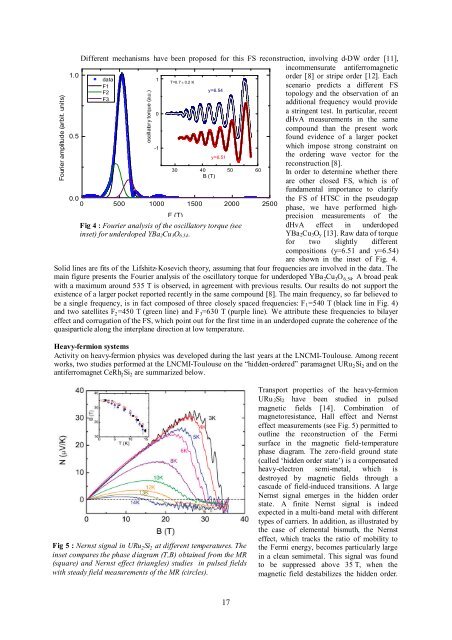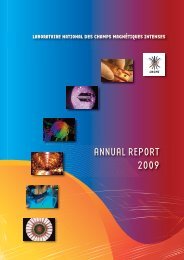Laboratoire National des Champs Magnétiques Pulsés CNRS – INSA
Laboratoire National des Champs Magnétiques Pulsés CNRS – INSA
Laboratoire National des Champs Magnétiques Pulsés CNRS – INSA
Create successful ePaper yourself
Turn your PDF publications into a flip-book with our unique Google optimized e-Paper software.
Fourier amplitude (arbit. units)<br />
1.0<br />
0.5<br />
Different mechanisms have been proposed for this FS reconstruction, involving d-DW order [11],<br />
incommensurate antiferromagnetic<br />
data<br />
F1<br />
F2<br />
F3<br />
oscillatory torque (a.u.)<br />
1<br />
0<br />
-1<br />
T=0.7 �0.2 K<br />
y=6.54<br />
y=6.51<br />
30 40<br />
B (T)<br />
50 60<br />
0.0<br />
0 500 1000 1500 2000 2500<br />
F (T)<br />
Fig 4 : Fourier analysis of the oscillatory torque (see<br />
inset) for underdoped YBa2Cu3O6.54.<br />
17<br />
order [8] or stripe order [12]. Each<br />
scenario predicts a different FS<br />
topology and the observation of an<br />
additional frequency would provide<br />
a stringent test. In particular, recent<br />
dHvA measurements in the same<br />
compound than the present work<br />
found evidence of a larger pocket<br />
which impose strong constraint on<br />
the ordering wave vector for the<br />
reconstruction [8].<br />
In order to determine whether there<br />
are other closed FS, which is of<br />
fundamental importance to clarify<br />
the FS of HTSC in the pseudogap<br />
phase, we have performed highprecision<br />
measurements of the<br />
dHvA effect in underdoped<br />
YBa2Cu3Oy [13]. Raw data of torque<br />
for two slightly different<br />
compositions (y=6.51 and y=6.54)<br />
are shown in the inset of Fig. 4.<br />
Solid lines are fits of the Lifshitz-Kosevich theory, assuming that four frequencies are involved in the data. The<br />
main figure presents the Fourier analysis of the oscillatory torque for underdoped YBa 2Cu 3O 6.54. A broad peak<br />
with a maximum around 535 T is observed, in agreement with previous results. Our results do not support the<br />
existence of a larger pocket reported recently in the same compound [8]. The main frequency, so far believed to<br />
be a single frequency, is in fact composed of three closely spaced frequencies: F1=540 T (black line in Fig. 4)<br />
and two satellites F 2=450 T (green line) and F 3=630 T (purple line). We attribute these frequencies to bilayer<br />
effect and corrugation of the FS, which point out for the first time in an underdoped cuprate the coherence of the<br />
quasiparticle along the interplane direction at low temperature.<br />
Heavy-fermion systems<br />
Activity on heavy-fermion physics was developed during the last years at the LNCMI-Toulouse. Among recent<br />
works, two studies performed at the LNCMI-Toulouse on the “hidden-ordered” paramagnet URu 2Si 2 and on the<br />
antiferromagnet CeRh 2Si 2 are summarized below.<br />
Fig 5 : Nernst signal in URu 2Si 2 at different temperatures. The<br />
inset compares the phase diagram (T,B) obtained from the MR<br />
(square) and Nernst effect (triangles) studies in pulsed fields<br />
with steady field measurements of the MR (circles).<br />
Transport properties of the heavy-fermion<br />
URu 2Si2 have been studied in pulsed<br />
magnetic fields [14]. Combination of<br />
magnetoresistance, Hall effect and Nernst<br />
effect measurements (see Fig. 5) permitted to<br />
outline the reconstruction of the Fermi<br />
surface in the magnetic field-temperature<br />
phase diagram. The zero-field ground state<br />
(called ‘hidden order state’) is a compensated<br />
heavy-electron semi-metal, which is<br />
<strong>des</strong>troyed by magnetic fields through a<br />
cascade of field-induced transitions. A large<br />
Nernst signal emerges in the hidden order<br />
state. A finite Nernst signal is indeed<br />
expected in a multi-band metal with different<br />
types of carriers. In addition, as illustrated by<br />
the case of elemental bismuth, the Nernst<br />
effect, which tracks the ratio of mobility to<br />
the Fermi energy, becomes particularly large<br />
in a clean semimetal. This signal was found<br />
to be suppressed above 35 T, when the<br />
magnetic field <strong>des</strong>tabilizes the hidden order.







